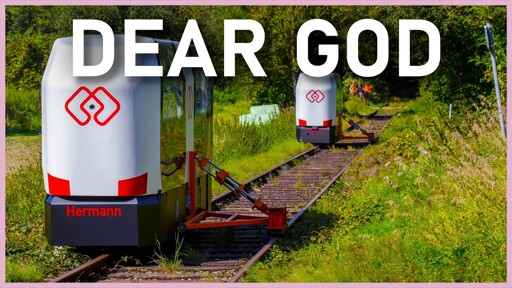The tram train idea is the best one.
https://youtu.be/r5M7Oq1PCz4 This one of his is funnier and makes better points.
Great, lets waste a few million euros on yet another “Dahir Insaat” style pod based Gadgetbahn. I can’t wait to stand in traffic in my pod because a lot of people want to exit at the same station.
If these dudes want to make a bunch of money just make the high speed trains and rail system we need in America. Everyone will buy tickets. You will be a literal train baron. I don’t get these half assed ideas. Just do the damn thing.
The are raising venture capital for whizzbang ideas rather than products that exist and require real planning, logistics, and engineering to bring to market in a cost effective way that will only generate enough profits to entice stable long-term investors with actual expectations. Like Tesla AI cabs rather than city bus/metro systems that do actual heavy-lifting to reduce traffic
Hey Groesbeek! Stelletje benzineverslaafde boomers! Zo, nu ik jullie aandacht heb, een oplossing, gezien jullie er geen zin in hebben dat er een grote zware spoorlijn dwars door je dorp gaat. Dus hier het alternatief:
Een tram.
Jullie hoeven een minder opzichtige halte te bouwen EN lichtere infra die veel beter bij de “Franse flair” van jullie straatbeeld past, terwijl de buren bij Nijmegen en Kleve hun spoorverbinding weer hebben. Iedereen blij.
Definitely the best solution.
We have a lot of abandoned rail here in Canada. I’ve often thought about making a very simple low-speed “rail chair with wheels” that I can put in my backpack and mess around with for fun. Hooking up to old rails is cool, but not as cool as having trains. Bring back trains!
Its illegal to be on or near railroad tracks though.
Doesn’t this usually only apply to active ones rather than abandoned track?
Only if you get caught ¯\_(ツ)_/¯
deleted by creator
Definitely be careful though! There’s plenty of rail that’s overgrown, horribly maintained, looks like it hasn’t been touched in 20 years but gets a train every few weeks or something. You’ll want to be very sure that it’s impossible for a train to be on the same track.
(There’s a town in my state that has some rail that is physically cut off from the railroad it used to be part of, so something like that would be the safest)
They need public transport but they are too proud to admit it
They want to monetize public transport without paying for building any new infrastructure.
Except by subsidizing the tech bros to do it, they think they’re offloading the risk when it fails and the opposition can’t blame them.
Pretty much the same reason CEOs are paid so much to be the fall guys, and also why CEOs and tech bros both think they are so much better than the rest of us.
Fuvk it; still better than cars. The physics alone are an improvement.
This is the problem with running a channel where the algorithm just wants you to be against stuff for clicks. You become jaded and start to work against what you originally set out to do.
What if these got popular on a disused line and the local authority notices there are suddenly a few thousand people a day using these things just to get off the road. Maybe that’s the start or a process to reinvest in a small service on that old line. Or if not, then it’s still a bunch of people not driving.
Or they could just pack up the company, go home and moan on the Internet about the situation…
i mean, they can’t work with a few thousand people. you’d need a few thousand pods, because they only take two people. and they can’t turn around by themselves, or navigate switches (look at the wheel profile), so you need new infrastructure for that. and they say that you order them via an app but since they can’t just go wherever you need to wait for a free track, so depending on where you are on the line you could need to wait for your ordered “pod” to navigate almost the entire system, waiting at stations behind other pods for who knows how long.
what’s more, this idea isn’t new: single-rail “gyrotrains” were invented in 1910, but never took off because of the extra mechanical complexity involved compared to jush using a normal train. and before you say “modern tech fixes that”, the main problem was that gyroscopic precession would fling the cars off of corners. that’s a physics problem which these pods appear to have solved by going extremely slow.
so, we have here a system that’s vastly more expensive, complex and unreliable than scheduled rail bus service, proposed to fix the same problem as scheduled rail bus service. just buy a rail bus.
I can see this working in places where there’s a single abandoned line and no budget to recover it. I’ve seen plenty of these in SE Asia. A small government investment (skip all the app bullshit etc) could make these work to inter connect small villages that otherwise would waste hours on shitty poorly maintained roads. If it can be made low-tech, I can see this being useful.
and unsurprisingly it’s a german project, a country which is absolutely fucking covered in rural lines that are just rusting away
like, holy shit, can we stop branding everything that isn’t a bog-standard train as “tech bro gadgetbahn”? this thing very explicitly has a specific problem it’s trying to solve.
Germans had a working solution to this for decades, but apparently gave up on it for some reason (not competitive with road traffic is probably the correct one)
It was called a railbus and they were once quite prevalent on European branch lines. Finland had and Sweden loads as well, in rural areas, until someone decided that a normal bus is better for some reason.
the problem is that you still need a driver, so frequency is going to be limited, which makes the service barely usable. Lack of places for vehicles to pass also limits possible frequency on these rural lines.
the idea behind monocab is that you can just throw more vehicles at the problem, so people can either just order a cab or you can have them constantly circulating like a very strange merry-go-round.
Railbuses are still good, but they made a lot more sense in the past. These days people have very very little tolerance for waiting.
If that pod can be automated, the rail bus can be automated.
Trains are expensive, high-capacity vehicles.
If these small cheap vehicles can repurpose tracks in low demand areas, what’s so bad about it?
exactly, i’m catiously optimistic because if this works it could be kinda revolutionary, if rural germans can be convinced to use some form of public transport that’s a huge step towards weaning that hideously car-brained nation off the deathmobiles.
and the big thing with these is that they just run on normal tracks, so you can just… start running normal trains once you see that ridership with the monocabs is reaching sufficient numbers!
Because 9/10 times they are awful, expensive, unused, and quickly shut down.
You don’t see any of these niche techslop pods operating anywhere you actually go, because they don’t work.
I don’t know why you’re being downvoted. I’d say you’re wrong, because it’s 10/10 times these things don’t work. I’ve seen many similar projects get proposed, funded and abandoned (even some that really did sound more efficient than this to me). The truth is, standard trains are still the cheapest thing you can put on those rails. They’re simple, repairable, predictable, they don’t break easily, can be easily driven by anyone or automated with standard systems that have been around for decades. Even if a small govt can’t buy a new train, they can get second hand trains from other cities, which will still work perfectly for decades.
have you actually looked at what we’re talking about, like at all? or are you just following the programming of “small vehicle=bad”?
okay so where do these things actually work?
on the testing tracks, because it’s new technology and needs to be exhaustively tested before the government allows it to be put into service.
like, trains were also new technology at one point, being new doesn’t somehow inherently make it bad lmao
Except this is not the first time this sort of thing has been proposed.
But you see, this is a small capacity, on demand monorail “pod” that serve the purpose of antisocial that is unwilling to share a public transport like the rest of the peasant do.
That’s exactly why tech bro solutions always have pods. Tells you a lot about their world views. Everyone outside their close social bubble is disgusting to them and needs to be separated from them.
But they’re not wrong. Look how many people use Uber instead of calling a cab. Look how many use Doordash instead of calling to order from a restaurant. Look how many use self checkout instead of going through an ordinary cashier lane.
People don’t want to interact with each other anymore. They don’t want to make phone calls with strangers. They don’t want to deal with strangers in person. They just want to push a button and get whatever it is that they want.
I think this is some kind of mass stress response to the alienation we all feel from living in modern cities. Of being sequestered into suburbs and having our lives regimented into school/work schedules. We’ve lost the sense of community we had from when we used to live in villages and walk around to get places and we knew everyone around us.
-
socially speaking, how is uber any different from a taxi? I’m not expected to share either of them with other passengers and both include a driver.
-
doordash offers delivery for many restaurants that dont have their own in house delivery, and again i don’t see much of a difference socially speaking either way.
-
i find most people only use the self check out when it is actually faster, if the line is shorter i frequently see people prefer a cashier. I use the cashier the vast majority of the time as i tend to get items with expiring soon discounts that need employee confirmation anyway. I often see people with a similar amount of grocceries beat me time wise by using the check out.
Overall i don’t think you are wrong and we are becoming less social with strangers, i just think some of the examples you used aren’t great.
Uber is different because you use an app instead of calling a person on the phone to order a cab. Furthermore, with an Uber you don’t even have to talk to the driver because they already know your destination.
DoorDash is similar: you use an app instead of placing an order over the phone. This is meaningful enough that many people switched to it even when their favourite restaurant already had delivery because they didn’t want to talk to someone on the phone.
-
And when the big collapse comes (not if, when) everyone will be doubly fucked because there is no solidarity or human kindness to wrestle the crises (plural).
Any close reading of the subject of small villages shows they were/are hotbeds of murder
By “close reading” you mean Agatha Christie novels? No seriously, where did you get that from?
Yes, and I was also humorously referring to the entire murder-in-a-small-town genre, including Midsummer, Cabot Cove, Shetland, and innumerable villages and small towns in… Wales, South Africa, Australia, France, Norway, all over the rural US, in both present and past eras.
The insularity being a contributor to motives for murder, between land disputes, scandalous secrets being hidden until they fester, and people who don’t have the option or opportunity to get away…
I wasn’t referring to the horror/slasher genre, but some of those fit as well.
The bigger question is why? And is it universal or is it specific to some places and/or some times.
Like I doubt small Japanese villages are hotbeds of murder. At the same time I fully believe American small towns have a lot of murders. So it’s a pretty strong claim to leap to the conclusion that small towns cause murder.
Hmmm… lately I’ve been reading a couple Japanese authors, Akimitsu Takagi and Seishi Yokomizo, in case you’re interested. (Not all set in remote places, but part of the classic murder mystery genre within a very different culture from Agatha Christie.)
Now that sounds really interesting! I saw the movie Yojimbo recently and that one depicts a Japanese village full of lawlessness and banditry, but that was set during the samurai era. My impression of Japanese villages today is that they’re rather idyllic places, albeit boring and lacking job opportunities (hence the exodus to Tokyo).
I will check out those authors though. Thanks for the info!
Because people are to unpredictable. The self checkout computer may have issues, but they’re the same issues every day. It doesn’t have emotional breakdowns, it doesn’t freak out over some product I’m buying, it doesn’t bore me with small talk while not scanning my shit. The only thing I don’t like about self checkout is you have to go bag everything yourself after paying and making everyone else sit there and watch you play tetris with your groceries. This same line of thinking applies everywhere because the root of it is the people.
As I’m typing this out it occurs to me that maybe we’ve done this to ourselves with too much convenience. This is what happens when convenience seeps into the service market. I want my interactions to be as seamless and convenient as possible. This necessarily means eventually removing the human element. The most unpredictable variable in the whole chain.
Can they just invent fucking human bubbles and we can adapt the logical already existent forms of public transport instead
I’m pretty sure this is just a way of utilizing abandoned rail lines that aren’t fit for full size trains.
Living not too far away from the place where the Moncocab is being developed and tested, I’ve actually had the chance to see them in person and actually sit in one (They are much more spacious than Adam makes them seem)
This system is not intended for mass transport. It is intended for rural places, connections between villages and small towns. A connection between bigger cities with these obviously makes no sense - for villages however these could be absolutely great.
Also, maybe this is worth mentioning. Monocab ain’t a profit oriented company (yet). It is a project by the Technical University Ostwestfalen-Lippe in cooperation with some other universities.
I can see why people are sceptical - but really this is a proof of concept. maybe it’ll turn out a flop - maybe it’ll work great. I am willing to see where they take it.
I’d think a short, reversible, single-car tram (like Coventry’s VLR) would work a hell of a lot better for connections between villages/small towns than Uber for rails with needlessly complicated gyroscopic bs.
Well, keep in mind we’re talking about long single tracks spanning many villages and towns - in places where there is not a ton of demand. The train would: 1. Rarely be there in the moment somebody actually needs it 2. Almost always be empty.
Notice I said the monocab ain’t meant as “mass” transport. You wont see 30 monocab back on back all the time - you’ll see one, maybe, every half an hour or so - but they’ll be there when somebody needs them - not uselessly when nobody cares.
These are much more, as somebody else already pointed out in the videos comments, I believe, indented to replace call busses - instead of having to call a bus and wait half an hour or more, you can just hop into a mobocab which is on standby and get moving.
you can just hop into a mobocab which is on standby and get moving
The train would: 1. Rarely be there in the moment somebody actually needs it 2. Almost always be empty.
The mobocabs won’t actually be there when someone needs them, either. They’re on rails. They’re not going to just be hanging out somewhere in the middle of the line so they can show up in a couple of minutes, they’ll be on standby at a trainshed on either end of the line. It’s going to take like 30 minutes for one to arrive – at that point you might as well just have a tram that comes every 30 minutes or so
transport to other towns is generally not a spur of the moment thing. checking a timetable is a lot easier for people in rural villages than using an app. one train every two hours is the norm here, and they stop at villages of a few hundred people.
See the whole video. Adam is using a clickbait title but the problem is actually a local Dutch government not the bros themselves, and the solution is a tram train.
Aside from it being built by tech bros, i actually like this. It could serve a purpose similar to public transport like car sharing (not carpooling) and rental bikes. This would be far from as efficient as regular trains or street cars, but those modes of transports need volume. As soon the population that uses the rail decreases to a point it becomes to expensive to run a train every one or two hours, often the expensive physical infrastructure remains while the service disappears. In those cases i could totally see this being a better option than heavily subsidising or totally removing trains on that section of rail. But to be honest, I can’t imagine there are enough of those places on earth carry the costs to develop this tech, also because these cars are only the best fit if the abandoned line is a single track line.
Glory be
I can’t wait for the horse to be invented again! Then running, then walking, then crawling, then swimming, then floating, then not moving at all and then death!








